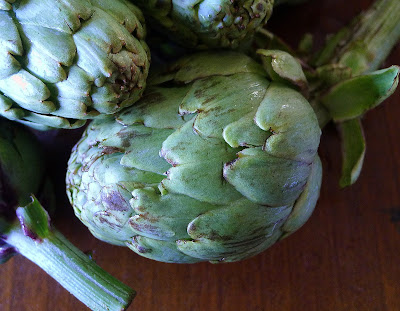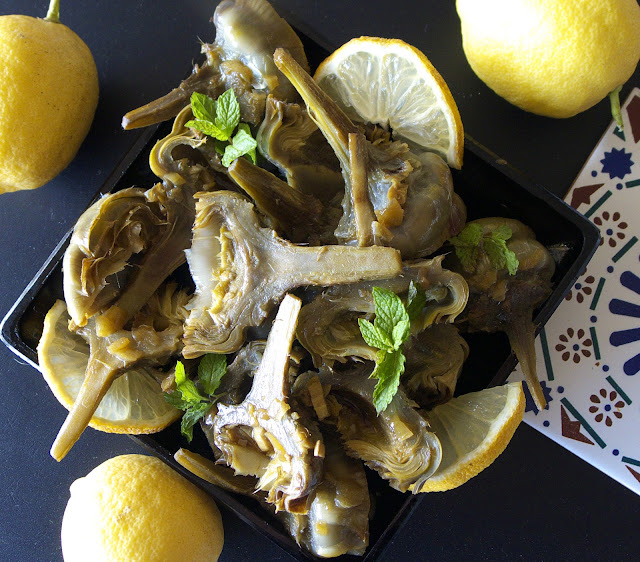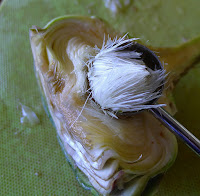Sardine season has arrived! ¡Que vivan las sardinas! Head for the beach to enjoy espetones, sardines skewered and grilled on a wood fire. Bake them with wine and pine nuts. Flour and fry the tiny ones. Get fancy with stuffed sardines. Add a vinegar marinade for escabeche, a terrific cold dish for summer. (See the links below for these recipes.)
“Smoked sardines” appear on chefs’ menus, but I haven’t been able to find them in cans. So I decided to smoke some myself. The process is pretty simple and no special smoker is needed. It does require several steps, starting five days in advance.
 |
| A plate of smoked sardines, ready to serve. |
 |
| Serve smoked sardines drizzled with olive oil on toasts. Strips of piquillo pepper are a good contrast. |
 |
| Two-toned smoked sardine fillets are due to smoking in two batches. The second batch is not so bronzed, as it needed to have the smoking herbs replenished. Next time I will know. |
 |
| Unzip sardine bones. |
1. Clean the sardines, fillet them. (Unlike canned sardines, the sardine bones won’t soften with cold-smoking.) Soak the fillets in ice water for one hour. Drain and dry them well.
2. Freeze the filleted sardines for 5 days. As the sardines will be cold-smoked (no direct heat), freezing eliminates any possible parasites that occur in raw fish. (For more information- plus recipes- about freezing fish for raw consumption: HOW NOT TO COOK YOUR FISH.)
3. Thaw the sardines overnight in the refrigerator. Dry them on layers of paper towels.
 |
| Place fillets on layer of salt. |
4. Layer the sardines with coarse salt. Leave them to cure, refrigerated, 30 minutes. Rinse off the salt and pat them dry. Air-dry them in a cool place one hour.
5. Line a heavy pan or flat-bottomed wok with foil. Place (store-bought) wood powder or chips, dried herbs, grape-vine twigs on top of the foil. Place a rack over the herbs. Cover the pan and place it on high heat until the contents are dried and beginning to smoke.
6. Place the sardine fillets on the rack in a single layer. Cover the pan. Heat on high until smoke fills the pan. Reduce heat to low and smoke the sardines 10 minutes.
 |
| Sardines smoke on a rack in a covered pan. |
Equipment and ingredients needed:
Paper towels
Coarse salt
Heavy pan with tight-fitting lid, preferably glass in order to gauge smoke
Aluminum foil
Rack to fit inside the pan
Dried herbs such as rosemary, thyme, fennel, lavender, bay leaf, citrus leaves, grape-vine twigs or store-bought wood chips or powder.
Smoked Sardines
Sardinas Ahumadas
Cut sprigs of fresh herbs several days before smoking and allow them to dry. Do the same if using, for instance, lemon peel or twigs of grape vines or fruit wood. You can also purchase wood chips or sawdust for smoking. You are not going to set the herbs on fire, but simply heat them on the stove until they begin to smoke. Lining the pan with foil prevents blackening the pan.
For the quick cure before smoking, you will need enough coarse salt to completely cover the sardine fillets. Sugar, black pepper, herbs, lemon or other aromatics can be added to the salt, if desired. These very small fish need only 20 to 30 minutes curing time. Longer and they will be way too salty. Likewise, they are fully smoked in 10 minutes. Longer smoking causes their flesh to harden.
How to serve smoked sardines:
Serve smoked sardines on toasts as an appetizer. Toss them with salad greens and vinaigrette. Mash them with creamed cheese and lemon juice to make a spread. Chop them into a chowder. Serve them, along with fried green peppers, as topping for a pan of migas (fried bread crumbs). Toss with spaghetti. 1 pound fresh sardines (approx. 20 fish)
1 cup coarse salt (8 ½ ounces)
1 tablespoon sugar
Sprigs of dried rosemary or thyme
Bay leaf
Citrus leaf or strip of lemon zest
Aromatic stove-top wood chips or powder (optional)
Extra virgin olive oil
Five days before smoking the sardines
Clean and fillet the sardines: Working on several thicknesses of newspaper, slide off the scales from the tail to the head. Cut off the heads and remove the guts. Grasp the top of the spine between thumb and forefinger. With the thumb and forefinger of the other hand, loosen the flesh around the spine and draw it down, “unzipping” the fillets as you go. Use kitchen scissors to cut away the spine, leaving the two fillets attached on the dorsal side and at the tail. Wash the fillets well and place them in a bowl. Cover them with salted ice water and let stand 1 hour.
 |
| Dry sardines on paper towel. |
Freeze the sardines. Rinse the sardines again. Pat them dry on paper towels. Place in a covered container and freeze them for 5 days. Thaw the sardines overnight in the refrigerator.
Cure the sardines in preparation for smoking
Combine the salt and sugar. Spread a layer of the salt mix in the bottom of a lidded container (glass or ceramic is best, plastic is acceptable). Spread a layer of sardine fillets, skin-side down, on the salt. Cover them with more salt. Add another layer of sardines and cover with salt.
Cover the container and refrigerate for 20 to 30 minutes. Remove the sardines from the salt. (Discard salt.) Wash the sardines in cold water. (If the sardines are not to be smoked immediately, cover and refrigerate them until ready to finish the process.) Dry the sardines on paper towels.
Place the sardine fillets on a rack in a cool, airy place or, uncovered, in the fridge so that their surface dries before smoking.
 |
| Place dried herbs, wood powder on foil in pan. |
Smoke the sardines
Use a heavy pot with tight-fitting lid. Line the pot with foil. Place sprigs of rosemary or thyme, bay leaf and citrus leaf or lemon zest and wood powder, if using, on the foil. Place a rack on top of the herbs. Put the lid on the pot and place it on a high heat until the contents are dried and beginning to create smoke.
Lay the sardines, skin side down, in a single layer on the rack. Return the pot to the heat. When the pot again fills with smoke, lower the heat to medium and smoke the sardines 10 minutes. Remove the pot from the heat and remove the lid. Carefully remove the rack with the sardines.
If smoking a second round of sardines, to create more aromatic smoke, add a few new sprigs of the dried herbs to the ones already in the bottom of the pan.
Place the smoked sardines on a serving plate. Drizzle them generously with olive oil. If they are to be stored, place the sardines in a container with a lid, cover them completely in oil and refrigerate them, covered, up to 1 week.
More recipes with sardines:






















.jpg)










